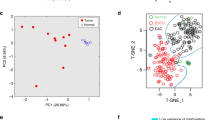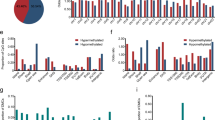Abstract
To identify dysregulated genes that may play a role in the pathogenesis of tobacco-related human squamous cell carcinoma (SCC), a cohort of SCCs from smokers (29 SCC of the head and neck, 3 SCC of the esophagus and 46 SCC of the lungs) were concomitantly analyzed for gene expression using Affymetrix U133A 2.0 arrays and for genomic variation using Affymetrix Human Mapping 100 K set. Gene expression profiling clearly separated benign squamous mucosa (BSM) from SCC and identified several candidate genes relevant to the biology of SCC. The single-nucleotide polymorphism array data adapted for copy number analysis identified two discrete areas of high-level genomic amplification, including 7p11.2 (EGFR (epidermal growth factor receptor)) and 11q13.3 (CCND1 (cyclin D1)). When gene expression measures were correlated with amplification status at 7p11.2 locus, EGFR overexpression in relation to benign tissue was dependent on amplification and occurred in only 9% of cases. However, an adjacent gene (∼0.4 Mb), EGFR-co-amplified and overexpressed protein (ECOP), showed strong over-expression in the majority (90%) of SCCs regardless of gene amplification status. This finding was corroborated with quantitative real-time PCR assays and protein immunoblots. Interestingly, small interfering RNA-mediated knockdown of ECOP gene products in a SCC cell line (SCC-9) resulted in increased cell death. The results of these studies identify ECOP as a protein relevant to the biology of SCC.
This is a preview of subscription content, access via your institution
Access options
Subscribe to this journal
Receive 50 print issues and online access
$259.00 per year
only $5.18 per issue
Buy this article
- Purchase on Springer Link
- Instant access to full article PDF
Prices may be subject to local taxes which are calculated during checkout




Similar content being viewed by others
References
Cromer A, Carles A, Millon R, Ganguli G, Chalmel F, Lemaire F et al. (2004). Identification of genes associated with tumorigenesis and metastatic potential of hypopharyngeal cancer by microarray analysis. Oncogene 23: 2484–2498.
Eley GD, Reiter JL, Pandita A, Park S, Jenkins RB, Maihle NJ et al. (2002). A chromosomal region 7p11.2 transcript map: its development and application to the study of EGFR amplicons in glioblastoma. Neuro Oncol 4: 86–94.
Ginos MA, Page GP, Michalowicz BS, Patel KJ, Volker SE, Pambuccian SE et al. (2004). Identification of a gene expression signature associated with recurrent disease in squamous cell carcinoma of the head and neck. Cancer Res 64: 55–63.
Park S, James CD . (2005). ECop (EGFR-coamplified and overexpressed protein), a novel protein, regulates NF-kappaB transcriptional activity and associated apoptotic response in an IkappaBalpha-dependent manner. Oncogene 24: 2495–2502.
Singh B . (2008). Molecular pathogenesis of head and neck cancers. J Surg Oncol 97: 634–639.
Stewart SL, Cardinez CJ, Richardson LC, Norman L, Kaufmann R, Pechacek TF et al. (2008). Surveillance for cancers associated with tobacco use--United States, 1999-2004. MMWR Surveill Summ 57: 1–33.
Talbot SG, Estilo C, Maghami E, Sarkaria IS, Pham DK, O-charoenrat P et al. (2005). Gene expression profiling allows distinction between primary and metastatic squamous cell carcinomas in the lung. Cancer Res 65: 3063–3071.
Toruner GA, Ulger C, Alkan M, Galante AT, Rinaggio J, Wilk R et al. (2004). Association between gene expression profile and tumor invasion in oral squamous cell carcinoma. Cancer Genet Cytogenet 154: 27–35.
Welsh JB, Sapinoso LM, Su AI, Kern SG, Wang-Rodriguez J, Moskaluk CA et al. (2001a). Analysis of gene expression identifies candidate markers and pharmacological targets in prostate cancer. Cancer Res 61: 5974–5978.
Welsh JB, Zarrinkar PP, Sapinoso LM, Kern SG, Behling CA, Monk BJ et al. (2001b). Analysis of gene expression profiles in normal and neoplastic ovarian tissue samples identifies candidate molecular markers of epithelial ovarian cancer. Proc Natl Acad Sci USA 98: 1176–1181.
Acknowledgements
We wish to thank Ms Angela Miller for her support of the histological techniques required to carry out these studies. We wish to thank Dr Patcharin Pramoonjago for assistance in the creation and evaluation of antibody reagents to the ECOP protein. Alex Baras is a member of the Biotechnology Training Program at The University of Virginia, supported by training grant, T32 GM008715, from the National Institutes of Health (USA). These studies were primarily supported by a grant from the Virginia Tobacco Settlement Foundation. This project was also supported, in part, by a gift provided to the University of Virginia by Philip Morris USA. The review and approval process was overseen by an External Advisory Committee without any affiliation with the University, PM USA, or any other tobacco company. Funding for this project was based upon independent intramural and extramural reviews.
Author information
Authors and Affiliations
Corresponding author
Additional information
Supplementary Information accompanies the paper on the Oncogene website (http://www.nature.com/onc)
Supplementary information
Rights and permissions
About this article
Cite this article
Baras, A., Yu, Y., Filtz, M. et al. Combined genomic and gene expression microarray profiling identifies ECOP as an upregulated gene in squamous cell carcinomas independent of DNA amplification. Oncogene 28, 2919–2924 (2009). https://doi.org/10.1038/onc.2009.150
Received:
Revised:
Accepted:
Published:
Issue Date:
DOI: https://doi.org/10.1038/onc.2009.150
Keywords
This article is cited by
-
VOPP1 promotes breast tumorigenesis by interacting with the tumor suppressor WWOX
BMC Biology (2018)
-
Epidermal growth factor receptor-coamplified and overexpressed protein (VOPP1) is a putative oncogene in gastric cancer
Clinical and Experimental Medicine (2015)
-
Detection of recurrent rearrangement breakpoints from copy number data
BMC Bioinformatics (2011)
-
Loss of VOPP1 overexpression in squamous carcinoma cells induces apoptosis through oxidative cellular injury
Laboratory Investigation (2011)
-
Oral cancer overexpressed 1 (ORAOV1) regulates cell cycle and apoptosis in cervical cancer HeLa cells
Molecular Cancer (2010)



